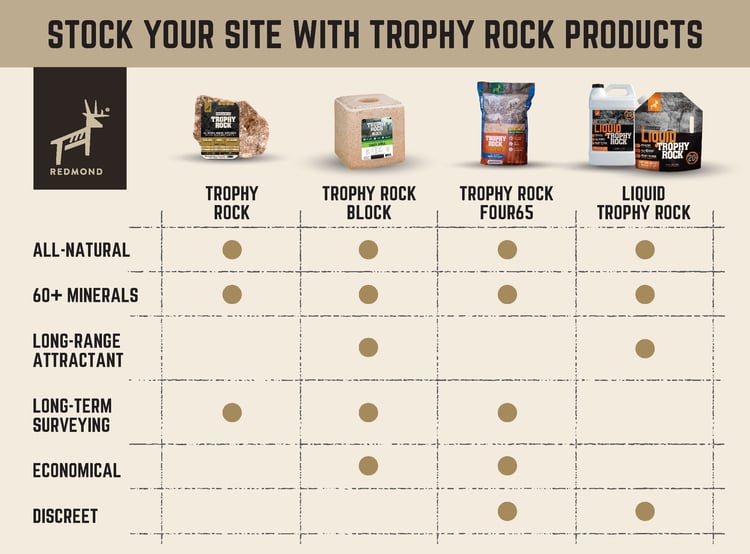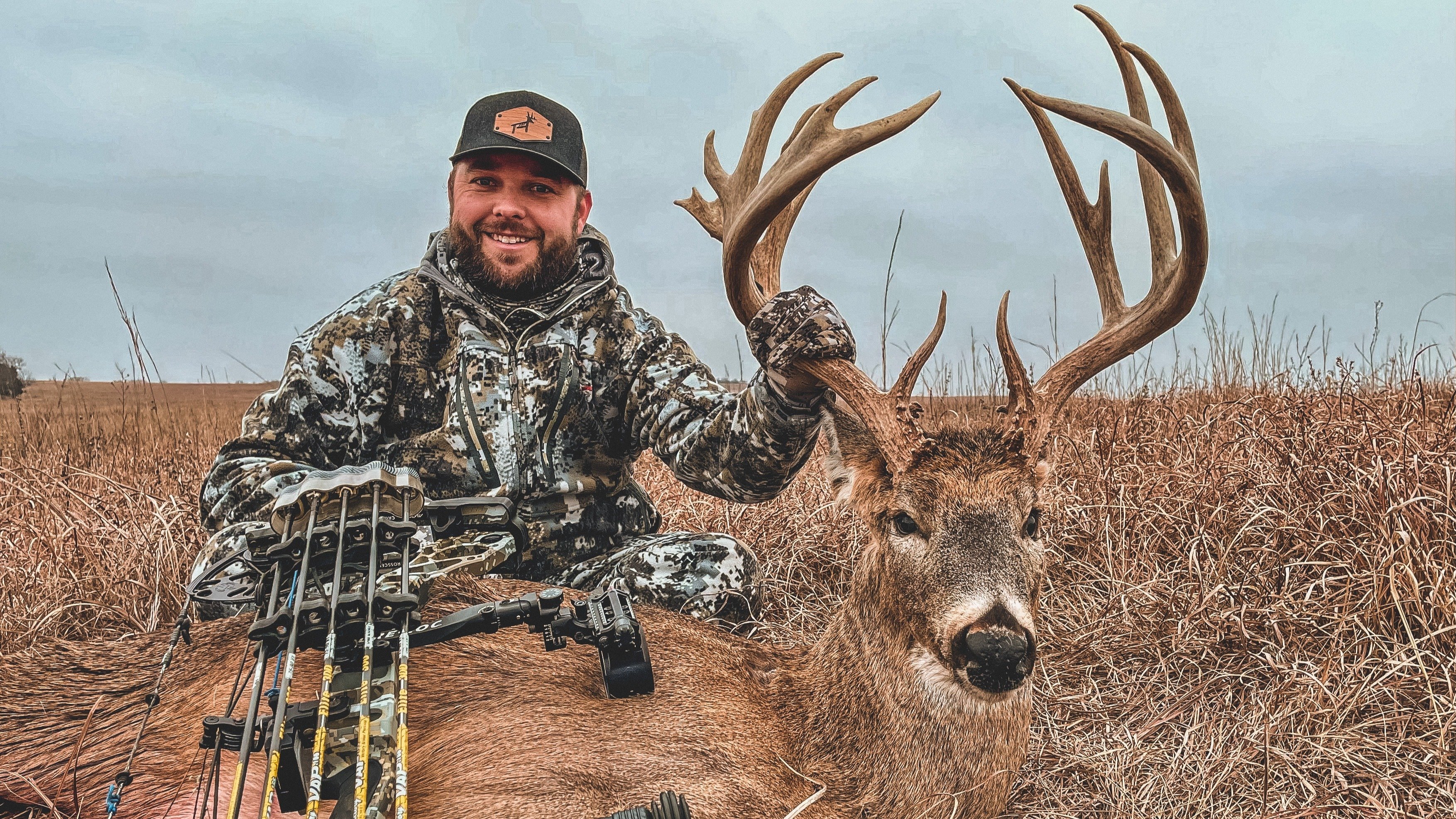Redmond Hunt Blog
Do Deer Need Minerals During Winter?
Redmond Hunt December 14, 2023
Learn how deer survive winter weather, what they eat, the best winter deer food plots and why feeding minerals in winter aids antler growth and herd health.
Hunting season has wound down and winter is once again howling at the door. It’s time to put your hunting gear away… then get back in the woods and start stocking your mineral sites. Why, you ask? You’re not attracting bucks or sitting in a stand in January, and deer won’t hit minerals hard till spring.
Many hunters who wait for March to recharge sites don’t understand the benefits of keeping minerals in front of whitetails during winter months. So when is the best time to put out minerals? Do deer use mineral licks in the winter? And what are the advantages of refreshing sites before spring?
We'll explore these questions and why supplementing deer with minerals in winter is great for herds and hunters. First, though, let's cover the conditions deer experience post-hunting season and what they look for in winter food sources.
Winter Stress in Deer
Wintertime brings the highest rate of natural mortality in adult bucks. The woods are blanketed in snow, preferred food sources are buried or gone, and many deer are just trying to hang on till spring. January through March is especially hard. Food scarcity and freezing temperatures following on the heels of the rut and months of hunting pressure create a powerful one-two punch of stress and deprivation. It’s a tough time for whitetails—a time when they need more food resources to overcome physical losses, and the time of year with the fewest available.
How Do Deer Survive Winter?
While winter is the most challenging season for deer, they don’t battle the elements unarmed. They’re equipped to weather the challenges hurled by nature. Tufts University notes deer stay warm in winter and combat scant forage and frigid conditions by:
- Growing a thicker winter coat and darker, longer guard hairs which absorb more sunlight and trap more body heat
- Retaining more fat in layers, increasing protection from the cold
- Hunkering down and moving less, helping them save energy and require less food
- Seeking sheltered areas that provide wind resistance and cover to rest and eat
What Do Deer Like to Eat in the Winter?
During wintertime, deer seek protein sources to rebuild muscle and regain body weight. But specifically, what food are they looking for? A significant part of the deer diet in winter includes native woody browse and remnants from agricultural crops. Stems, twigs, grasses, food plots, and leftover nuts and fruits, where available, also supplement nutrition.
If you want to help promote natural food sources on your deer hunting property, try these two suggestions:
- Encourage forest cover. Promote more natural winter deer food by thinning mature forests and putting sunlight back on the ground so woody browse can grow abundantly.
- Plant winter food plots. Some of the best food plots for deer in the winter include annual clovers and perennial white and chicory clovers with brassicas. They’re preferred by deer, nutritious, and often last through winter and spring when planted in the fall.
Hunters and conservationists also have the power to arm deer with another wintertime tool: a viable mineral site. Supplementing minerals lessens the effects of winter stress and gives them a jumpstart on spring growth. Let's drill down on why.
Importance of Minerals for Deer
Whitetails need minerals for everything—digestion, reproduction, fetal growth, body and antler growth, and nearly every other physiological function. But providing access to minerals can also benefit hunters. This Texas Parks and Wildlife Department article notes that supplementation of feed and minerals:
- Promotes trophy-class animals at an earlier age
- Lowers post-rut mortality in bucks
- Enables deer to reach their genetic potential
- Fosters more quality deer in a given area
- Smooths out “boom or bust” population cycles
The need for minerals—whether obtained through existing habitat or supplementing—is undisputed. And while spring green-up is when deer really amp up mineral use, providing minerals in winter is also worthwhile and elevates overall health. (Learn more about why whitetails need minerals in the video below.) Let's cover some specific functions minerals assist does and bucks with during winter months.
Doe Winter Mineral Needs
Most does head into winter with a baby (or two) on the way. That means they require additional minerals to support gestation and, eventually, lactation. Keeping does healthy and providing nutrients during pregnancy (late fall through spring) helps them sustain newly conceived fawns and helps you ultimately grow a healthier herd.
Buck Winter Mineral Needs
Bucks head into winter run down from the rut and depleted of energy, protein, and mineral reserves. If a buck enters early spring still low in minerals—particularly calcium and phosphorus—it can delay antler growth. Let's explore why.
Early antler growth originates from nutrients received during the previous fall and winter. In fact, nearly 90 percent of calcium and phosphorus in a buck's body is banked in the skeletal system. Around March, their bodies transfer those minerals from the bones to begin growing antlers. If a buck doesn’t have sufficient minerals stored, antler growth is stunted until he consumes enough minerals through diet.
This National Deer Association article notes, “Clearly minerals are important in antler development,” and “supplementation prior to and during antler growth may be beneficial.” The same article explains that while calcium and phosphorus are the most plentiful minerals in whitetails’ antlers, lesser amounts of potassium, barium, iron, aluminum, zinc, strontium, and manganese are also present.
Putting out a block in winter or natural Redmond Trophy Rock with a full spectrum of balanced minerals is a great way to jumpstart antler growth and ensure bucks have the nutrients needed to grow a healthy rack come spring.
Setting Up a Winter Mineral Site for Deer
You now know the importance and benefits of offering balanced minerals during winter. It supports antler growth in bucks, fetal development in pregnant does, and helps grow a healthier herd overall. If you already have an established mineral site, pick up your preferred supplements and hit refresh! If you’re new to setting up a mineral site, this article explains how and where to do it.

Best Minerals for Deer in Winter
Redmond has you covered if you want quality, versatile minerals to nourish deer. We offer all-natural supplements to suit your herd's year-round needs: original Trophy Rock; Trophy Rock Block—a great mineral block for deer in winter; Four65 granular minerals, and Liquid Trophy Rock attractant. Our products are proven effective, mined in the USA, and contain 60+ natural trace minerals deer needs for optimal growth and health. Click below to visit our online store and pick up trusted Redmond deer mineral products today.
© Redmond Hunt 2023. All rights reserved.



.jpg)
